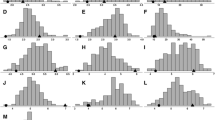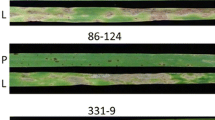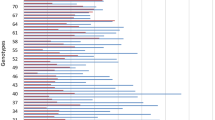Abstract
Key message
Tan spot susceptibility is conferred by multiple interactions of necrotrophic effector and host sensitivity genes.
Abstract
Tan spot of wheat, caused by Pyrenophora tritici-repentis, is an important disease in almost all wheat-growing areas of the world. The disease system is known to involve at least three fungal-produced necrotrophic effectors (NEs) that interact with the corresponding host sensitivity (S) genes in an inverse gene-for-gene manner to induce disease. However, it is unknown if the effects of these NE–S gene interactions contribute additively to the development of tan spot. In this work, we conducted disease evaluations using different races and quantitative trait loci (QTL) analysis in a wheat recombinant inbred line (RIL) population derived from a cross between two susceptible genotypes, LMPG-6 and PI 626573. The two parental lines each harbored a single known NE sensitivity gene with LMPG-6 having the Ptr ToxC sensitivity gene Tsc1 and PI 626573 having the Ptr ToxA sensitivity gene Tsn1. Transgressive segregation was observed in the population for all races. QTL mapping revealed that both loci (Tsn1 and Tsc1) were significantly associated with susceptibility to race 1 isolates, which produce both Ptr ToxA and Ptr ToxC, and the two genes contributed additively to tan spot susceptibility. For isolates of races 2 and 3, which produce only Ptr ToxA and Ptr ToxC, only Tsn1 and Tsc1 were associated with tan spot susceptibility, respectively. This work clearly demonstrates that tan spot susceptibility in this population is due primarily to two NE–S interactions. Breeders should remove both sensitivity genes from wheat lines to obtain high levels of tan spot resistance.




Similar content being viewed by others
Abbreviations
- LOD:
-
Log of odds ratio
- QTL:
-
Quantitative trait locus
- MAS:
-
Marker-assisted selection
- MIM:
-
Multiple interval mapping
- NE:
-
Necrotrophic effector
- RIL:
-
Recombinant inbred line
- Ptr :
-
Pyrenophora tritici-repentis
- S :
-
Sensitivity gene
- SNP:
-
Single-nucleotide polymorphism
- SSR:
-
Simple sequence repeat
- Tsn :
-
Tan spot necrosis
- Tsc :
-
Tan spot chlorosis
References
Abeysekara NS, Friesen TL, Liu ZH, McClean PE, Faris JD (2010) Marker development and saturation mapping of the tan spot Ptr ToxB sensitivity locus Tsc2 in hexaploid wheat. Plant Genome 3:179–189
Ali S, Gurung S, Adhikari TB (2010) Identification and characterization of novel isolates of Pyrenophora tritici-repentis from Arkansas. Plant Dis 94:229–235
Cheong J, Wallwork H, Williams KJ (2004) Identification of a major QTL for yellow leaf spot resistance in the wheat varieties Brookton and Cranbook. Aust J Agric Res 55:315–319
Chu CG, Friesen TL, Xu SS, Faris JD (2008) Identification of novel tan spot resistance loci beyond the known host-selective toxin insensitivity genes in wheat. Theor Appl Genet 117:873–881
Chu CG, Chao S, Friesen TL, Faris JD, Zhong S, Xu SS (2010) Identification of novel tan spot resistance QTLs using an SSR-based linkage map of tetraploid wheat. Mol breed 25:327–338
Ciuffetti LM, Manning VA, Pandelova I, Betts MF, Martinez JP (2010) Host-selective toxins, Ptr ToxA and Ptr ToxB, as necrotrophic effectors in the Pyrenophora tritici-repentis-wheat interaction. New Phytol 187:911–919
Effertz RJ, Anderson JA, Francl LJ (2001) Restriction fragment length polymorphism mapping of resistance to two races of Pyrenophora tritici-repentis in adult and seedling wheat. Phytopathology 91:572–578
Effertz RJ, Meinhardt SW, Anderson JA, Jordahl JG, Francl LJ (2002) Identification of a chlorosis-inducing toxin from Pyrenophora tritici-repentis and the chromosomal location of an insensitivity locus in wheat. Phytopathology 92:527–533
Faris JD, Friesen TL (2005) Identification of quantitative trait loci for race-nonspecific resistance to tan spot in wheat. Theor Appl Genet 111:386–392
Faris JD, Anderson JA, Francl LJ, Jordahl JG (1996) Chromosomal location of a gene conditioning insensitivity in wheat to a necrosis-inducing culture filtrate from Pyrenophora tritici-repentis. Phytopathology 86:459–463
Faris JD, Anderson JA, Francl LJ, Jordahl JG (1997) RFLP mapping of resistance to chlorosis induction by Pyrenophora tritici-repentis in wheat. Theor Appl Genet 94:98–103
Faris JD, Zhang Z, Lu HJ, Lu SW, Reddy L, Cloutier S, Fellers JP, Meinhardt SW, Rasmussen JB, Xu SS, Oliver RP, Simons KJ, Friesen TL (2010) A unique wheat disease resistance-like gene governs effector-triggered susceptibility to necrotrophic pathogens. Proc Natl Acad Sci USA 107:13544–13549
Faris JD, Zhang Z, Rasmussen JB, Friesen TL (2011) Variable expression of the Stagonospora nodorum effector SnToxA among isolates is correlated with levels of disease in wheat. Mol Plant Microbe Interact 24:1419–1426
Faris JD, Abeysekara NS, McClean PE, Xu SS, Friesen TL (2012) Tan spot susceptibility governed by the Tsn1 locus and race-nonspecific resistance quantitative trait loci in a population derived from the wheat lines Salamouni and Katepwa. Mol Breed 30:1669–1678
Faris JD, Liu Z, Xu SS (2013) Genetics of tan spot resistance in wheat. Theor Appl Genet 126:2197–2217
Figueroa M, Manning VA, Pandelova I, Ciuffetti LM (2015) Persistence of the host-selective toxin Ptr ToxB in the apoplast. Mol Plant Microbe Interact 28:1082–1090
Friesen TL, Faris JD (2004) Molecular mapping of resistance to Pyrenophora tritici-repentis race 5 and sensitivity to Ptr ToxB in wheat. Theor Appl Genet 109:464–471
Friesen TL, Faris JD (2010). Characterization of the wheat-Stagonospora nodorum disease system: what is the molecular basis of this quantitative necrotrophic disease interaction. Can J Plant Pathol 32:20–28
Hosford RM Jr (1982) Tan spot-developing knowledge 1902–1981, virulent races and differentials, methodology, rating systems, other leaf diseases, literature. In: Hosford, RM Jr. (ed) Tan spot of wheat and related diseases workshop. North Dakota Agric Exp Station, Fargo, pp 1–24
Joehanes R, Nelson JC (2008) QGene 4.0, an extensible Java QTL-analysis platform. Bioinformatics 24:2788–2789
Kariyawasam GK, Carter AH, Rasmussen JB, Faris JD, Xu SS, Mergoum M, Liu ZH (2016) Genetic relationships between race-nonspecific and race-specific interactions in the wheat–Pyrenophora tritici-repentis pathosystem. Theor Appl Genet 129:897–908
Knot DR (1990) Near-isogenic lines of wheat carrying genes for stem rust resistance. Crop Sci 30:901–905
Lamari L, Bernier CC (1989a) Toxin of Pyrenophora tritici-repentis: host specificity, significance in disease, and inheritance of host reaction. Phytopathology 79:740–744
Lamari L, Bernier CC (1989b) Evaluation of wheat lines and cultivars to tan spot Pyrenophora tritici-repentis based on lesion type. Can J Plant Pathol 11:49–56
Lamari L, Strelkov SE (2010) The wheat/Pyrenophora tritici-repentis interaction: progress towards an understanding of tan spot disease. Can J Plant Pathol 32:4–10
Liu ZH, Friesen TL, Rasmussen JB, Ali S, Meinhardt SW, Faris JD (2004) Quantitative trait loci analysis and mapping of seedling resistance to Stagonospora nodorum leaf blotch in wheat. Phytopathology 94:1061–1067
Liu ZH, El-Basyoni I, Kariyawasam G, Zhang G, Fritz A, Hansen JM, Marais F, Friskop AJ, Chao S, Akhunov E, Baenziger PS (2015) Evaluation and association mapping of resistance to tan spot and Stagonospora nodorum blotch in adapted winter wheat germplasm. Plant Dis 99:1333–1341
Lorieux M (2012) MapDisto: fast and efficient computation of genetic linkage maps. Mol Breed 30:1231–1235
Manning V, Ciuffetti LM (2015) Necrotrophic effector epistasis in the Pyrenophora tritici-repentis -wheat interaction. PLoS One. 10:e0123548
Mereno MV, Stenglein S, Perello AE (2015) Distribution of races and Tox genes in Pyrenophora tritici-repentis isolates from wheat in Argentina. Trop Plant Pathol 40:141–146
Moffat CS, See PT, Oliver RP (2014) Generation of a ToxA knockout strain of the wheat tan spot pathogen Pyrenophora tritici-repentis. Mol Plant Pathol 15:918–926
Noriel AJ, Sun XC, Bockus W, Bai G (2011) Resistance to tan spot and insensitivity to Ptr ToxA in wheat. Crop Sci 51:1059–1067
Nyarko A, Singarapu KK, Figueroa M, Manning VA, Pandelova I, Wolpert TJ, Ciuffetti LM, Barbar E (2014) Solution NMR structures of Pyrenophora tritici-repentis ToxB and its inactive homolog reveal potential determinants of toxin activity. J Biol Chem 289:25946–25956
Oliver RP, Friesen TL, Faris JD, Solomon PS (2012) Stagonospora nodorum: from pathology to genomics and host resistance. Ann Rev Phytopathol 50:23–43
Orolaza NP, Lamari L, Ballance GM (1995) Evidence of a host-specific chlorosis toxin from Pyrenophora tritici-repentis, the causal agent of tan spot of wheat. Phytopathology 85:1282–1287
Rees RG, Platz GJ, Mayer RJ (1982) Yield losses in wheat from yellow spot: comparison of estimates derived from single tillers and plots. Aust J Agric Res 33:899–908
Schilder AMC, Bergstrom GC (1994) Infection of wheat seed by Pyrenophora tritici-repentis. Can J Bot 72:510–519
Shi G, Friesen TL, Saini J, Xu SS, Rasmussen JB, Faris JD (2015) The wheat Snn7 gene confers susceptibility on recognition of the Parastagonospora nodorum necrotrophic effector SnTox7. Plant Genome 8:2. doi:10.3835/plantgenome2015.02.0007
Singh S, Bockus WW, Sharma I, Bowden RL (2008a) A novel source of resistance in wheat to Pyrenophora tritici-repentis race 1. Plant Dis 92:91–95
Sun X-C, Bockus WW, Bai GH (2010) Quantitative trait loci for resistance to Pyrenophora tritici-repentis race 1 in a Chinese wheat. Phytopathology 100:468–473
Virdi SK, Liu ZH, Overlander ME, Zhang ZC, Xu SS, Friesen TL, Faris JD (2016) New insights into the roles of host gene-necrotrophic effector interactions in governing susceptibility of durum wheat to tan spot and Septoria nodorum blotch. G3. doi:10.1534/g3.116.036525
Wolpert TJ, Dunkle LD, Ciuffetti LM (2002) Host-selective toxins and avirulence determinants: what’s in a name? Ann Rev Phytopathol 40:251–285
Zhang Z, Friesen TL, Simons KJ, Xu SS, Faris JD (2009) Development, identification, and validation of markers for marker-assisted selection against the Stagonospora nodorum toxin sensitivity genes Tsn1 and Snn2 in wheat. Mol Breeding 23:35–49
Zurn JD, Newcomb M, Rouse MN, Jin Y, Chao S, Sthapit I, See DR, Wanyera R, Bonman JM, Brueggeman RB, Acevedo M (2014) High-density mapping of a resistance gene to Ug99 from the Iranian landrace PI 626573. Mol Breed 34:871–881
Acknowledgements
This material is based upon work supported, in part, by the National Institute of Food and Agriculture, United States Department of Agriculture (USDA), under Hatch project number ND02224. The development and genotyping of LMPG-6/PI 626573 population was funded by the North Dakota Wheat Commission.
Author information
Authors and Affiliations
Corresponding author
Ethics declarations
Conflict of interest
The authors declare no conflict of interest for this article.
Ethical standards
All experiments complied with the ethical standards of the university.
Additional information
Communicated by Evans Lagudah.
Rights and permissions
About this article
Cite this article
Liu, Z., Zurn, J.D., Kariyawasam, G. et al. Inverse gene-for-gene interactions contribute additively to tan spot susceptibility in wheat. Theor Appl Genet 130, 1267–1276 (2017). https://doi.org/10.1007/s00122-017-2886-4
Received:
Accepted:
Published:
Issue Date:
DOI: https://doi.org/10.1007/s00122-017-2886-4




